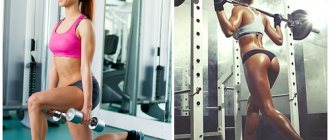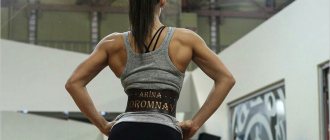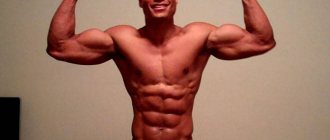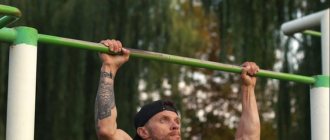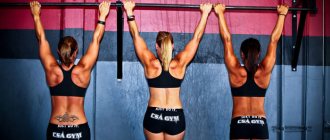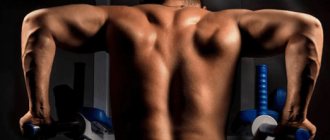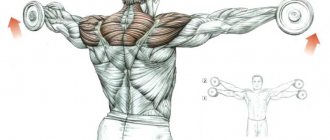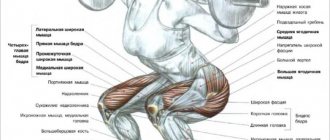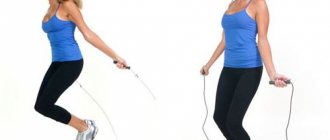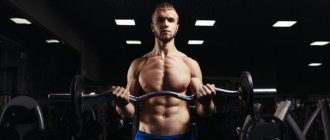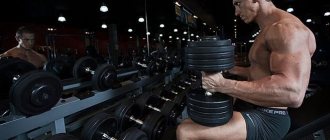Pull-ups with additional weight are a great way to increase muscle mass. They begin to be performed when regular pull-ups on the horizontal bar are no longer enough: over time, the muscles get used to working with the athlete’s body weight and they need a larger load. Experts recommend moving on to this exercise if you can do up to 15 regular pull-ups in each of 4 approaches.
To avoid injuries and sprains, it is necessary to increase additional weight gradually. The training should be carried out on a horizontal bar, the crossbar of which can be reached without jumping - this way you will reduce the risk of mixing of the spinal discs. If the horizontal bar is located high, use special stands or a wall bars to start and finish the exercise. Exercises with additional weight are contraindicated for those who have problems with the spine.
Features and benefits of the exercise
Pull-ups with weights help work your back muscles and biceps. It trains strength and endurance, and makes it possible to increase muscle mass. This exercise is suitable for those who have already mastered regular pull-ups and are confident that their technique is correct.
In addition to increasing muscle mass, pull-ups help maintain body tone, improve strength, and also have a beneficial effect on posture and spinal muscles. But, of course, one must remember that weights must be used carefully, and when using them, the importance of correct exercise technique is especially important.
Training program for the impatient
This program is aimed at increasing muscle mass; only those who have already mastered the correct technique and can do pull-ups at least 15 times can start training in it. To start with weights, you should perform 12 arm curls on the bar. After the exercise is completed, add a load and do 10 pull-ups. Exercises alternate according to the following scheme:
- 1st approach - 12 times;
- 2nd approach - 10 times;
- 3rd approach - 8 times;
- 4th approach - 6 times.
Thus, each repetition begins with an increase in additional load. The program is designed to increase muscle mass, so four approaches will be enough. If your goal is to improve endurance, then to achieve the effect you need to use light weights, but do 2-3 times more pull-ups on the horizontal bar.
In conclusion, we note that the main components of success are the correct technique and regularity of training. In addition, do not forget to alternate and combine pull-ups with different grips in order to comprehensively work the muscles and prevent them from getting used to the same load.
What muscles work?
Weighted pull-ups work the same muscle groups as the non-weighted exercise, namely the biceps, shoulder muscles, latissimus and teres dorsi. Additionally, the abdominal and leg muscles receive static load, which keep the body straight, preventing swaying and odors.
The load on muscle groups will differ depending on how the hands and head are positioned on the bar. The wider the arms are, the more the latissimus dorsi muscles are loaded. If they are located narrowly, then the biceps are worked to a greater extent. The reverse close grip uses the lower portions of the latissimus muscles, which are usually not used with other exercises. If we are talking about pulling up head first, in which the athlete comes out with the back of his head to the top point in front of the crossbar, then in this case the latissimus dorsi muscles increase in width. If the bar remains in front of your face, then you are working more to thicken your back muscles.
Useful properties of pull-ups[edit | edit code]
Muscles involved (description)
Perhaps I dug too deep in the previous paragraph. Or maybe I just spent too much time alone thinking about push-ups and pull-ups. Or maybe both. Who knows? But whether you agree with my theory or not, there is no denying that pull-ups are underappreciated by modern athletes. When the torso is mentioned, everyone thinks of chest muscles, strong arms and broad shoulders. While these pushing muscles are certainly important, compared to the musculature of the upper back - the pulling muscles - they are just stifling muscles. The largest muscle in the body, the latissimus dorsi, originates from the armpits and, covering the lower corner of the shoulder blade, descends down to form a “wing.” Most of the back muscles—the trapezius, posterior deltoids, rhomboids, teres—are worked in pulling exercises, but virtually all the work is done by the latissimus dorsi. These muscles are not only large, but also amazingly responsive—as if their cells are programmed to grow larger when stimulated. Look at modern bodybuilders - their most impressive muscles are not on their legs or arms, but on their backs; many of these guys have latissimus dorsi muscles that look almost like wings. Even avid bodybuilders who find it incredibly difficult to add volume to their chests find that after working the latissimus dorsi muscles, their chests literally become larger before their eyes. It’s as if these muscles, powerful tools mastered by our ancestors, are in hibernation, but are ready to grow at any moment, as if by magic.
Unfortunately, modern back training programs include far from safe exercises with barbells and dumbbells, which increase the load on the lower back and spine, and this, in turn, leads to damage and stress. This is probably due to the wide variety of exercise machines - from horizontal and vertical rows to seated blocks. Why are they so popular? Yes, because exercises on machines are much easier to do! You can sit or even lie down and play the weight back and forth. Exercise machines make it easier to do exercises - there is no benefit from them until steroids are used. And guys on steroids don’t get stronger, they just get blown away in all directions, and they look like an absurd pile of muscles.
Forget about all the exercises you did in the gym - they are not needed. The fastest and, most importantly, safest way to develop your back is with modest pull-ups. This is the main exercise for the back, because nature itself has built the pull-up mechanism into the human body, and all you need to do is simply “wake up” it. In the modern world there are not many situations in which pull-ups can be used, but we cannot refuse such a rich genetic inheritance. All the pulling muscles are involved in the pull-up - every muscle is worked, and in a very short time your shoulders will become powerful and your fingers strong as steel.
Pull-ups build muscle and strengthen your fingers and hands, even if you don't do any special exercises. The rotator cuff receives its share of the payload. Moreover, pull-ups strengthen your abs and thighs - they receive an isometric load, because in ordinary life you rarely have to hang, lifting yourself off the ground. For beginners, the abs ache even more than the back muscles.
Weighted pull-ups: technique
Pull-ups with additional weight are very similar in technique to regular pull-ups, but, nevertheless, there are a number of nuances due to the use of weight:
- Do not jump onto the horizontal bar suddenly or jump off it. Such movements can cause injuries to the joints and spine. It is recommended to climb onto a special stand and grab the horizontal bar with your hands. When going down, also first stand on the stand, and then carefully step down to the floor.
- Working with weights does not allow any jerking or swinging.
You can start mastering the exercise with negative pull-ups.
They suggest that you skip the phase of raising the body by standing on a platform or step, but perform the phase of lowering the body. That is, by extending your arms, you slowly lower yourself down from the top point, then climb up the step again, and so on. This will help prepare your muscles for full pull-ups. First you need to choose the right weight with which you will work. As for the most convenient and safe options, this is a special vest that does not put pressure on the shoulders and spine, but at the same time effectively increases the load. A belt is also used for weighted pull-ups. Typically, such devices allow you to gradually increase the weights used, which is convenient for long-term work. You can replace the vest with a backpack filled with something heavy. Let's take a the equipment for weights for pull-ups:
- Regular backpack. The easiest and most affordable method to provide additional weight. It is not intended for heavy loads, but it will withstand a couple of pancakes, which will be enough for the initial stage.
- Weighted vest. A now popular device that does not put unnecessary stress on the spine, and at the same time allows you to change the load in a wide range.
- Weightlifting belt for pull-ups. You can easily attach a weight to the belt. It has special chains on which weights of 1-50 kg are attached. Don't rush to use heavy weights right away. It's better to start small and gradually increase them. To prevent the plates from interfering with the exercise, you can squeeze them between your legs.
The choice of weight is also important . It all depends on the goal you are pursuing. Determine your maximum weight with which you can fully do one pull-up without jerking or breaking technique. Next, choose the weight and number of repetitions depending on what you want to achieve:
- If you want to increase muscle size, use 70-85% of your maximum weight. It is recommended to do 8-12 repetitions. Perform the latter almost to failure.
- Wanting to improve the strength of the muscles of the back and arms , use heavy weights of 85-95% of the maximum. Do 2-4 repetitions, and the rest between them should be longer.
- To train strength endurance, you should use weights of 50-70% of the maximum. You need to do a lot of repetitions - 15-20.
Put on weights and go to the horizontal bar. The height of the crossbar should be such that you can reach it by raising your arms without jumping. If you only have access to a high bar, use a box, stool, or other supply.
- Grasp the bar with your preferred grip.
- Exhaling, bend your arms and pull your body up until your upper chest reaches the level of the bar and your chin is above it.
- As you inhale, smoothly, without throwing your body down, return to the starting position. Repeat the exercise as many times as necessary.
What about the relief
First of all, weighted pull-ups are a basic exercise. And as everyone knows, the base builds the optimal ratio of muscle mass. It includes working the back, biceps, forearms and others. Therefore it develops the whole body completely.
Due to its functionality, pull-ups with additional weight activate the entire body, which prevents you from gaining excess weight. If you remember acrobats and look at their body, you can be sure that the relief is the result of pulling up with weight.
To develop relief, you should consume less carbohydrates and more protein in your diet. Thus, muscle tissue will receive everything it needs for development.
To develop relief, it is better to take a small weight as an additional one. Muscle dryness is achieved by a large number of repetitions of the movement. The optimal amount is 15-18 times. The number of approaches must be at least five.
Variations of the exercise
In fact, any existing type of pull-up can be complicated by using additional weights. Pull-ups with a load can be different in the way of grip: it can be neutral, straight or overhand, reverse or underhand. The reverse grip for pull-ups is the most common. It allows you to work your biceps and forearm. A direct grip is more aimed at the back muscles, and a neutral grip is more aimed at the triceps.
Pull-ups differ in grip width . It can be narrow, medium (about shoulder width) or wide. The wider the grip, the more the latissimus dorsi muscles are loaded; the narrower it is, the more actively the biceps and pectoral muscles work.
At the point of contact of the crossbar, pull-ups can be standard and behind the head. With a standard pull-up, the chest touches the bar, the load is uniform, and the entire layer of the latissimus muscles actively works. Touching behind the head, in which the bar touches the neck, works the upper part more.
There are also one-arm pull-ups. With weights, this exercise is very difficult and is only suitable for experienced athletes, so beginners should not experiment with them. In general, you can alternate between different pull-ups with weights, the benefits of which you know, thereby alternating types of load.
How to learn to do pull-ups
To learn how to do pull-ups, you first need to lose weight, that is, lose excess weight to make the task easier for our muscles.
If it’s hard to do pull-ups or you can’t do them at all, then start with the vertical pull-down exercise. You need to learn the perfect technique for this exercise. There is an article about how to learn to do pull-ups.
How should you learn to do pull-ups? We just take it and start doing pull-ups on the horizontal bar (if we don’t have excess weight). There is no need to chase results, there is no need to try to create quantity - do quality.
The simplest program to learn how to do pull-ups on the bar
Approach the horizontal bar and try to do one pull-up with perfect technique and sit down to rest. Then again once with the correct technique and this can be done ad infinitum. And you can do this for 10-20-30 approaches until your arms start to get tired. And over time, you will be able to do 2 times in a set, then 3, and so you can learn to do pull-ups.
How to properly help your partner learn to do pull-ups
When you weigh 80 kg or more, you need help or use a gravitron, a weight-bearing simulator that helps us partially reduce body weight, it pushes us up and helps us pull ourselves up. But if it's not there.
The easiest way is to hire an assistant. You can often see in the hall when an assistant tries to help a person pull himself up and begins to push the one who is studying in the back. And this is a grave mistake.
Why can’t you help pull yourself up by leaning on your back?
When you push into the back of someone who is doing a pull-up, you confuse their nervous system. When the person has already prepared, tensed his muscles and began to pull the horizontal bar towards him, you begin to push him in the back. At this moment, the brain automatically removes part of the impulse from the back, that is, it begins to work less intensely. Because external interference begins, which should not exist. Roughly speaking, we are distracted from the exercise, although we do not want this. The legs are not used during pull-ups, and so they can be used to help pull yourself up to the bar.
What muscles work when doing a pull-up?
Only the upper part of the body, the torso, is active in pulling up. During pull-ups, only the muscles of the upper body work:
- Back
- Pectoral muscles
- Shoulders
- Hands
The legs do not work in this exercise, and you step like weights that pull us down.
Contraindications and precautions
Despite all the benefits of the exercise, you need to know that pull-ups with weights, which you already know, are not suitable for everyone. They are contraindicated if you have problems with the spine. You should also take into account that using weights increases the risk of injuries and sprains several times, so be careful and hone the ideal technique for performing the exercise .
Additionally, to ensure your weighted pull-up programs are as safe and effective as possible, consider the following:
- When working with weights, it is strictly forbidden to jump up to the bar. This can cause severe stretching of the spine. You need to get to it carefully, using a hill or a wall bars.
- You need to rise and fall as smoothly and slowly as possible. Jerking and swaying of the body should be excluded from movements. Pull yourself up slowly, controlling the work of all muscles. It is also necessary to descend smoothly. The descent should take you a few seconds. At the bottom, linger a little and relax as much as possible, only after the load completely stops oscillating can you begin to pull yourself up.
When you finish pulling yourself up, do not jump off the bar suddenly. Get down from the horizontal bar carefully, in the same way you got to it. In no case should this rule be ignored, since the spine is stretched during pull-ups, and sudden movements can provoke a pinched nerve or hernia, as well as more serious injuries.
- As you pull yourself up, keep your back and shoulders tense.
- If you do not try to squeeze your shoulder blades a little while hanging on the bar, but give your arms the opportunity to stretch up and press against your ears, you can damage the shoulder joint, ligaments or small muscles, and also provoke pain. Therefore, be careful and try to hold your body weight and weights not with your hands, but with your back. Lower your shoulders slightly and straighten your chest, while tensing your latissimus muscles.
- An important point is breathing. Inexperienced athletes often pull themselves up as they exhale, throwing their head back strongly and squeezing their shoulders. This technique is extremely incorrect, as there is a risk of severe damage to the cervical spine. In addition, it does not allow the back muscles to be properly worked, thanks to which the upward movements of the body occur. Breathe smoothly and measuredly. Raise your body as you exhale, lower it as you inhale.
- The main mistake beginners make when doing weighted pull-ups is over-swaying. This should be avoided, remembering that pull-ups should be performed vertically by bending the elbows and without using leg swings.
You should not start using weights if you are not confident in the correct technique. Make sure that regular pull-ups are easy for you and that you are doing them correctly, and only then make the load more difficult. Otherwise, the exercise may not only be ineffective, but also unsafe.
Body weights and pull-ups[edit | edit code]
Pull-ups require you to lift your entire body weight, which is what makes them different from other exercises. Literally, this means that every additional kilogram of weight you have to lift upward. The more excess weight you have, the more difficult it will be to do pull-ups and the worse your results will be.
Muscle weight is not a hindrance to pull-ups: if you have a lot of it, it will be easier to do pull-ups.
But if the excess weight exceeds 13 kg, your chances of advancing beyond the Fifth Level are practically zero, unless you have crazy strength and do not use deception techniques. Otherwise, just keep working on pull-ups, paying as much attention to technique as possible, doing other Big 6 exercises, going on a diet - you will certainly succeed.
